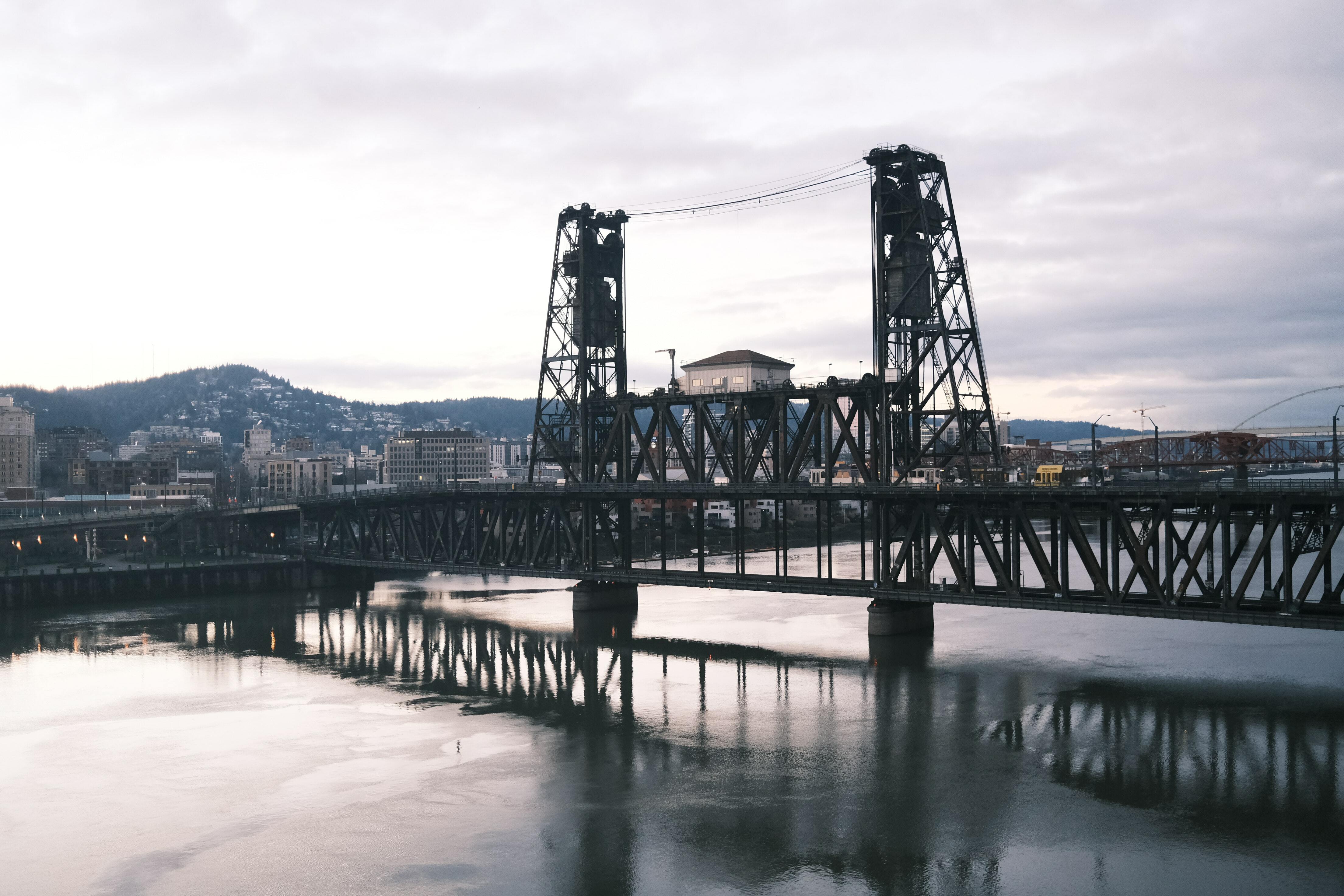What is Bracing in construction?
Bracing in construction is referred to as the use of structural elements or systems to provide strength, support, and stability to the building or structure. It is used to resist external forces like heavy wind loads, seismic loads, earthquakes, and other loads caused by building vibrations or sways. Bracing is crucial for ensuring the integrity, safety, and minimization of damage to the structure. Steel members are used to strengthening braced constructions, enhancing their tensile and compressive strength.
Columns and beams carry the vertical loads of the building in frame construction while bracing bears the horizontal load. The basic goal of bracing in any construction is to keep it stable and prevent it from collapsing. All horizontal loads are transferred from the frame to the foundation.
Types of Bracing System
There are two types of bracing systems used in building construction:-
Horizontal Bracing System
- Bracing is provided on each floor (in horizontal planes) to offer load paths for the transference of lateral forces to the vertical bracing planes.
- It is necessary to provide bracing on every floor. The floor system itself can provide sufficient resistance, but the roof may require bracing.
- Horizontal bracing systems are intended to transmit horizontal loads from columns at the structure’s perimeter to vertical bracing planes.
- The pressure of wind forces on the cladding of the structure causes horizontal forces on the columns near the structure’s edge.
- Horizontal bracing has two types, which are used for multi-story steel structures:
1. Diaphragms Bracing 2. Discrete triangulated Bracing.
Vertical Bracing System
- It not only transfers the horizontal loads of the structure to the foundations but also protects the structure from sways and vibrations.
- The bracings in the vertical planes are located between the column lines, providing load channels that are utilized to transmit horizontal forces to the ground level, and this system will transfer horizontal loads to the foundations.
- Framed buildings need at least three vertical bracing planes to withstand torsion about a vertical axis and brace both directions in the layout.
Structural Mechanism of Bracing System
All of these bracing systems perform differently under gravity and lateral loads. Below, we have discussed the mechanisms of two different bracing systems against the loading cases, which are gravity and lateral loads.
Behavior of bracing systems under lateral loads
The whole design of the tall structures is governed by the lateral forces induced by the wind. Braced frames are considered one of the most efficient elements to resist these lateral forces in either direction. The primary function of these bracings is to resist all the horizontal shear induced by the lateral forces. The mechanism to resist horizontal shear can be understood by following the path of the horizontal shear along the frame. That can be explained by considering the four types of bracings subjected to lateral loading, as shown in the figure 1 below.
It is very clear after understanding Figure 1 below that when the diagonals are subjected to compression, the horizontal web members will go under the axial tension for equilibrium in the lateral direction. Which results in shear deformation of the braced bent.
In the case of K-bracings, half of the members, both horizontal and inclined, will be subjected to tension and compression simultaneously. All the forces and deformations in each member of the braced bent will be reversed as the building is subjected to lateral loading in opposite directions. [1]
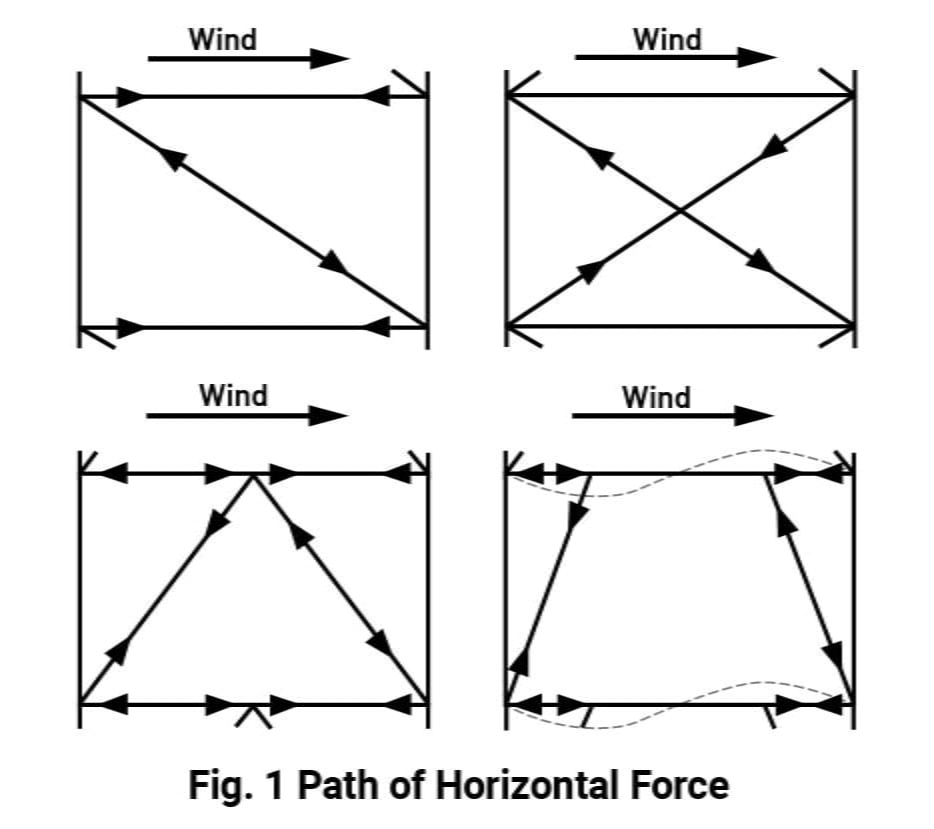
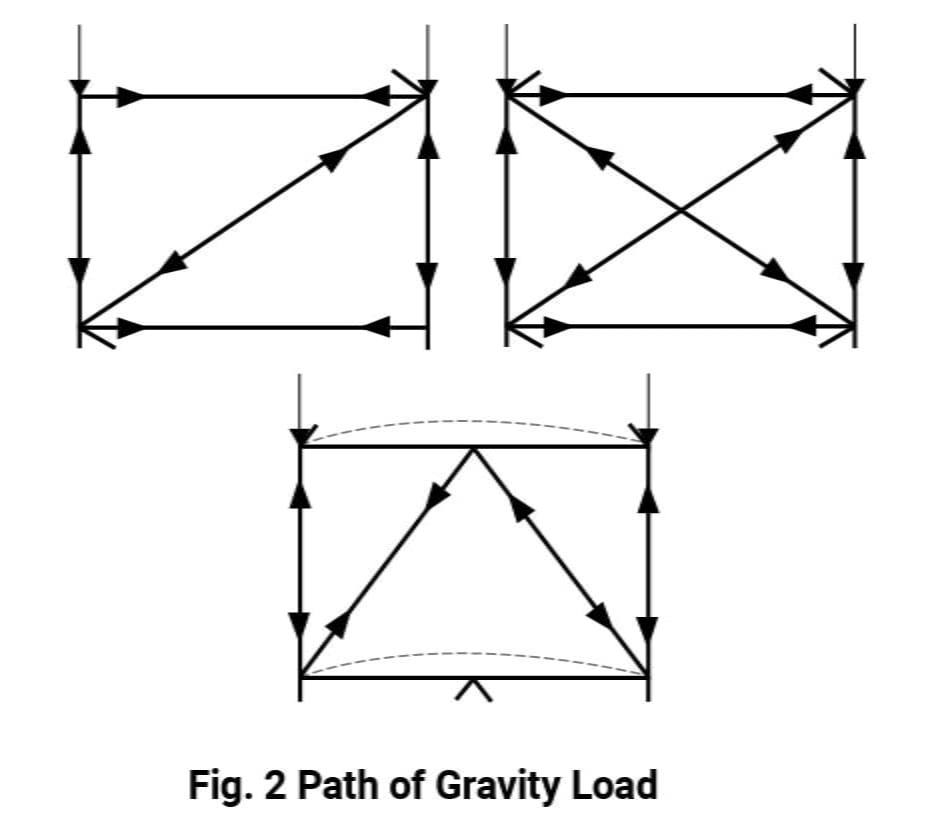
Behaviour of bracing systems under gravity loads
Under the action of gravity loads, the columns shorten axially because of the compressive loads. The bracing system undergoes compression, and the beam undergoes axial tension due to the typing actions, as shown in figure 2 above. In cases where diagonals are not connected at the ends of the beams, the diagonal members will not carry any force because no restraint is provided by the beams to develop force. Therefore, such bracing will not take part in resisting the gravity loads. [1]
Types of Bracing
- Diagonal or Single Bracing
- Cross Bracing or X Bracing
- K Bracing
- V Bracing
- Chevron Bracing
- Eccentric Bracing
Diagonal Bracing
- In a rectangular frame, the braces are placed diagonally to stabilize the structure and resist tension as well as compression.
- A diagonal bracing can be a single diagonal or a double diagonal. Having double diagonal bracing is more beneficial than single bracing, as it can resist more loads.
- A diagonal bracing is considered more efficient in resisting the lateral forces caused by the wind, as a diagonal bracing forms a perfect vertical truss. [1]
- Diagonal bracings are designed to withstand tension and compression forces. [2]
- Sufficiently resistant to tension and compression.
- Here bracing is placed at an angle of 45° for an efficient system, and this type of arrangement is strong.
- Vertical bracing is specially designed to resist high wind loads and horizontal forces acting on it.
- If we increase the bracings at the vertical plane, then it will automatically improve the structural stability.
Cross or X Bracing
- Cross bracing used two diagonal members intersecting each other, which was suitable to resist tension only.
- Cross bracing can interfere with the position and operation of door and window openings, causing higher bending in the floor beams.
K Bracing
- Connects to the columns at mid-height.
- K bracing offers room or space between them, which allows an architect to design doors and windows in those openings. That’s why they are also proffered over diagonal bracings. [1]
- These frames are more flexible and they have provisions to provide openings in the outer face, which results in the least bending in floor beams.
- K bracing is not used in seismic areas due to the danger of column failure if the compression brace buckles.
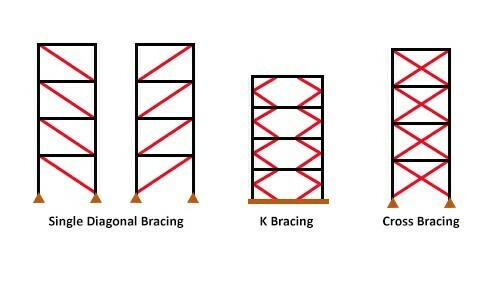
V Bracing
- This bracing consists of two diagonal members moving down, from the two corners of the horizontal member and meeting the center point of horizontal members, which forms the shape of the letter V.
- V bracings are also known as chevron bracing (it is just the inverse of V bracing. Look at the figure below.)
Eccentric Bracing
- It is commonly used in seismic regions.
- It is similar to V-bracing but its bracing members don’t meet at the center, they are slightly far from each other.
- This is done so that the ‘link’ between the bracing members absorbs seismic energy through plastic deformation.
- Eccentric single diagonals can be utilized to support a frame as well.
- Just like K bracings, eccentric bracings also offer space between them, which allows you to add doors and windows in those openings.

Uses of Bracing
- Bracings are used to stabilize the structures
- Used in bridges to support frames.
- Used for bulking control of the main beams.
- It helps in load distribution.
- Used for dimensional controls.
Advantages of Bracing
- As compared to non-braced structures, structures that have a bracing system offer great protection against high-speed wind storms and earthquake loads.
- Bracings like diagonal and cross are very effective in reducing the vibrations and sways in tall buildings, providing a secure and comfortable environment for the occupants.
- Bracing helps in the distribution of loads more efficiently throughout the structure. Doing so enables it to carry heavier loads without compromising the structure’s integrity.
- It increases structural stability by resisting lateral forces such as wind or seismic stresses. It is critical for tall buildings, bridges, and other structures where stability is the number one concern.
- Used to resist the bulking of the main beam in the structure.
- To provide strength to the existing structure.
- Helps in distributing lateral and vertical loads equally to the structure.
- It is cost-effective and flexible to design.
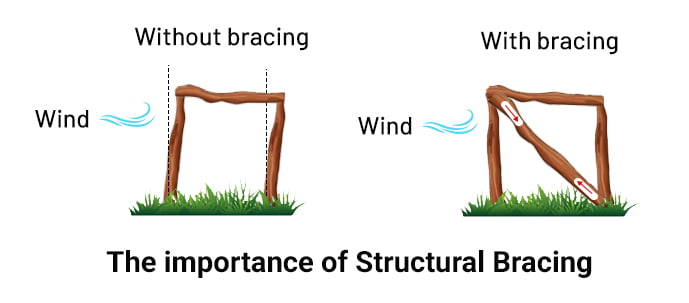
Disadvantages of Bracing
- When reinforced, the length of the span of the structures is limited to 40 feet.
- Some types of bracing, like diagonal and cross bracing, restrict openings and disturb the aesthetics of the building.
- Bracing systems often require additional space within the building envelope, which can reduce the usable floor area or interfere with architectural design elements.
- It acts like an obstruction to natural light penetration and also interferes with the layout of interior spaces. Which can be problematic in residential or commercial buildings where openness and visibility are desired.
- Bracing elements may require regular inspection and maintenance to ensure their effectiveness over time. This can add to the long-term operational costs of a building.
- Installation of Bracing system requires skilled workmanship.
- Seismic region changes that rely on altitude.

